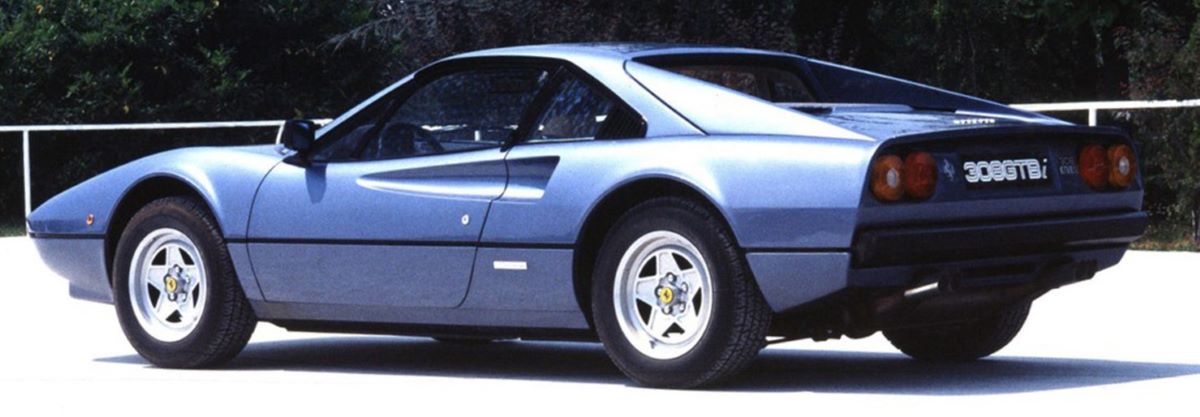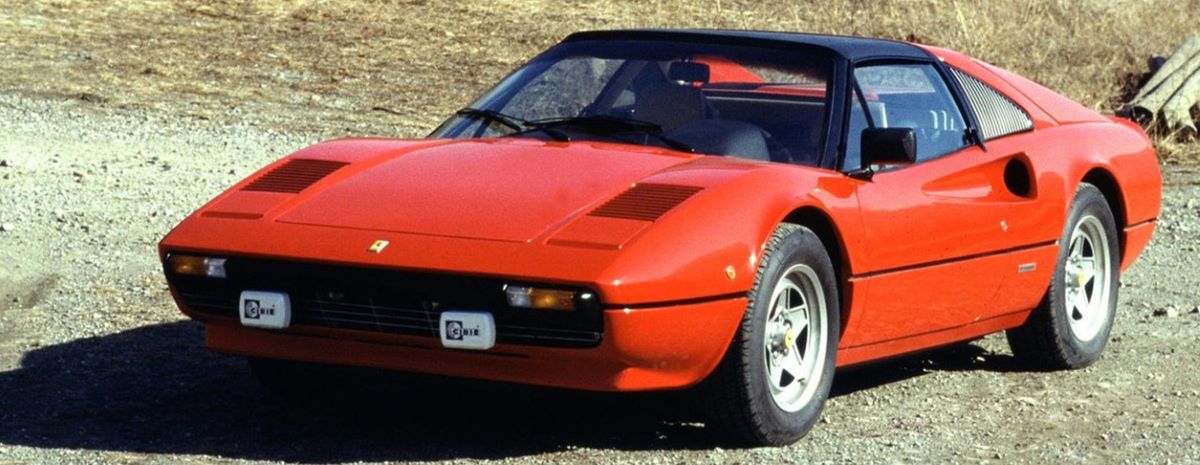
308 GTBi
The GTBi’s coachwork remained largely unchanged with respect to the 308 GTB, apart from a few modifications to the interior. The most important changes, however, were made to the engine. In fact, in competition, fuel injection systems had replaced the traditional stacks of carburettors and, as transferring racing experience to production cars has always been part of the Ferrari mission, adopting fuel injection systems was in line with this, helping indirectly to comply with new exhaust emission norms.
With worldwide legislation increasing to reduce exhaust emissions, fuel injection was adopted on the 308 GTB in late 1980, and the model became the 308 GTBi, the “i” suffix in the model designation referring to the fitment of fuel injection. Visually the new model was almost identical to the outgoing one, although the casting pattern of the five spoke alloy wheels changed slightly due to the fitment of Michelin TRX metric size radial tyres. However, the imperial size Michelin XWX tyres on 14″ wheels, or Pirelli P7 tyres on 16″ wheels were available as an option.
As with the exterior, the interior was very similar to the 308 GTB model, the main differences being that the leather trimmed bucket seats had a different stitch pattern, whilst the main instruments were maintained in a hooded nacelle in front of the driver, the clock and oil temperature gauge were moved to a panel at the front of the centre console to make them more easily visible in a separate panel on the lower left edge of the dashboard. The steering wheel design was also changed to one with satin black spokes, featuring longitudinal slots. As with the preceding model the gear lever in an open gate was mounted in the centre console alongside the ashtray, as was the ancillary switchgear and the handbrake.
The main European market 308 GTBi models had a tubular chassis with factory type reference F 106 BB 100. Disc brakes, with independent suspension via wishbones, coil springs, and hydraulic shock absorbers, were provided all round, with front and rear anti roll bars. All models were numbered in the Ferrari odd number road car chassis sequence, with both right and left hand drive available. Production ran from 1980 through to 1982, during which time 494 examples were produced in the chassis number range 31327 to 43059.
The transversely mid-mounted aluminium V8 engine was essentially of the same design as that used in the preceding 308 GTB model, but with a fuel injection system replacing the quadruple twin choke carburettors fitted to the former. It was of a 90 degree configuration, with belt driven twin overhead camshafts per bank, having a total capacity of 2926cc, with a bore and stroke of 81mm x 71mm, bearing factory type reference F 106 BB 000 for European market cars. The engine was coupled in unit with the all synchromesh five speed transmission assembly, which was below, and to the rear of the engine’s sump. The gear and final drive ratios were altered to suit the revised characteristics of the fuel injected engine. It was fitted with a Bosch K Jetronic fuel injection system, coupled to a Marelli MED 803A Digiplex electronic ignition system, incorporating a coil, distributor and ignition module to serve each bank of cylinders. From this model onwards all world market 308 series cars were fitted with wet sump lubrication. The claimed power output was 214bhp for European market models, and 205bhp for US market examples, which were fitted with power sapping emission control equipment.

308 GTSi
This spider version of the 308 GTBi shared both its line and engine. The fuel injection system gave both models much smoother power delivery. Unfortunately, meeting anti-pollution regulations meant that a few horses had to go, and the cleaner engines were less powerful than the previous carburettor ones. Aware of this situation and the need to re-establish its cars at the top their class, Ferrari immediately began further development of the V8 engine with the aim of increasing power whilst still keeping exhaust emissions within acceptable levels.
Fuel injection was adopted on the 308 GTS in late 1980 concurrently with the 308 GTB model, and the model became the 308 GTSi, the “i” suffix in the model designation referring to the fitment of fuel injection. Visually the new model was almost identical to the outgoing one, although the casting pattern of the five spoke alloy wheels changed slightly due to the fitment of Michelin TRX metric size radial tyres. However, the imperial size Michelin XWX tyres on 14″ wheels, or Pirelli P7 tyres on 16″ wheels were available as an option. As with the 308 GTS targa roof model, the removable roof panel was stowed in a cover behind the seats when not in use, and the rear quarter windows behind the doors featured hinged satin black finished slatted covers.
As with the exterior, the interior was very similar to the 308 GTS model, the main differences being that the leather trimmed bucket seats had a different stitch pattern, whilst the main instruments were maintained in a hooded nacelle in front of the driver, the clock and oil temperature gauge were moved to a panel at the front of the centre console to make them more easily visible in a separate panel on the lower left edge of the dashboard. The steering wheel design was also changed to one with satin black spokes, featuring longitudinal slots. As with the preceding model the gear lever in an open gate was mounted in the centre console alongside the ashtray, as was the ancillary switchgear and the handbrake.
The main European market 308 GTSi models had a tubular chassis with factory type reference F 106 BS 100. Disc brakes, with independent suspension via wishbones, coil springs, and hydraulic shock absorbers, were provided all round, with front and rear anti roll bars. All models were numbered in the Ferrari odd number road car chassis sequence, with both right and left hand drive available. Production ran from 1980 through to the beginning of 1983, during which time 1749 examples were produced in the chassis number range 31309 to 43079.
The transversely mid-mounted aluminium V8 engine was essentially of the same design as that used in the preceding 308 GTS model, but with a fuel injection system replacing the quadruple twin choke carburettors fitted to the former. It was of a 90 degree configuration, with belt driven twin overhead camshafts per bank, having a total capacity of 2926cc, with a bore and stroke of 81mm x 71mm, bearing factory type reference F 106 BB 000 for European market cars. The engine was coupled in unit with the all synchromesh five speed transmission assembly, which was below, and to the rear of the engine’s sump. The gear and final drive ratios were altered to suit the revised characteristics of the fuel injected engine. It was fitted with a Bosch K Jetronic fuel injection system, coupled to a Marelli MED 803A Digiplex electronic ignition system, incorporating a coil, distributor and ignition module to serve each bank of cylinders. From this model onwards all world market 308 series cars were fitted with wet sump lubrication. The claimed power output was 214bhp for European market models, and 205bhp for US market examples, which were fitted with power sapping emission control equipment.
Engine
- Type……………………………………rear, transverse, 90° V8
- Bore/stroke…………………………81 x 71 mm
- Unitary displacement…………..365.86 cc
- Total displacement………………2926.90 cc
- Compression ratio………………..8.8 : 1
- Maximum power…………………157 kW (214 hp) at 6600 rpm
- Power per litre…………………….73 CV/l
- Maximum torque…………………243 Nm (24.8 kgm) at 4600 rpm
- Valve actuation……………………twin overhead camshafts per bank, two valves per cylinder
- Fuel feed…………………………….Bosch K-Jetronic injection
- Ignition……………………………….electronic, single spark plug per cylinder
- Lubrication…………………………wet sump
- Clutch………………………………..single-plate
Chassis
- Frame…………………………………tubular steel
- Front/Rear suspension………..independent, unequal-length wishbones, coil springs over telescopic shock absorbers, anti-roll bar
- Brakes……………………………….discs
- Transmission……………………..5-speed + reverse
- Steering……………………………..rack-and-pinion
- Fuel tank……………………………capacity 74 litres
- Front tyres………………………….205/70 VR 14
- Rear tyres…………………………..205/70 VR 14
Bodywork
- Type……………………………………two-seater berlinetta or two-seater targa-top
- Length………………………………..4230 mm
- Width…………………………………1720 mm
- Height………………………………..1120 mm
- Wheelbase…………………………..2340 mm
- Front track………………………….1460 mm
- Rear track……………………………1460 mm
- Weight………………………………..1286 kg (dry) berlinetta / 1297 kg (dry) targa-top
Performance
- Top speed……………………………240 km/h


You must be logged in to post a comment.